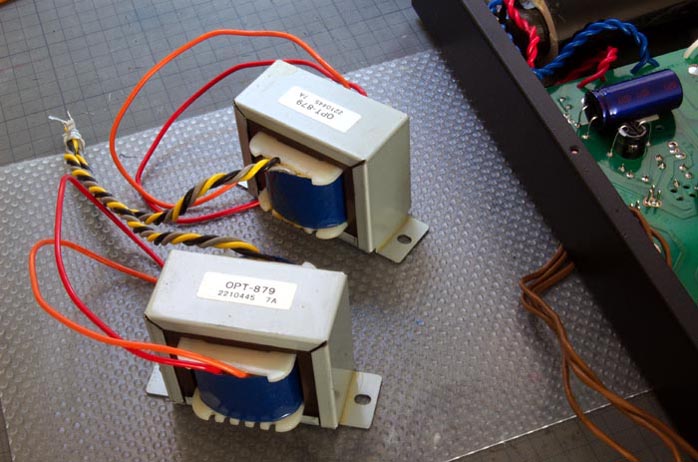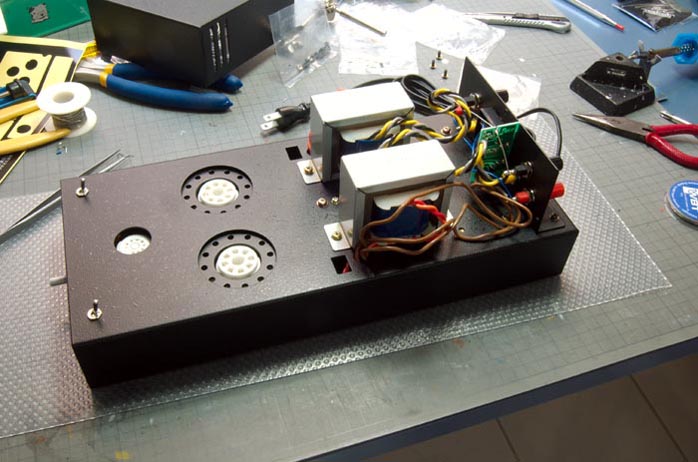|
|
|
|
|
This review page is supported in part by the sponsors whose ad banners are displayed below
|
|
 |
|
I kicked off the second round with higher power. To my surprise, the Electro-Harmonix KT88EH somehow lost that magical deep timbre of the 6L6. Not that the bass completely vanished but the lower octave harmonics seemed to be diluted though violin was sugar-coated with very rich harmonics as were soprano vocals. While the guitar tambora in Manjón's Tango wasn't as deep, it had more woody decay. The delicate lute-like melodic line in Cano's Estudio No. 7 was more romantically sweet. Although the gain in the high to midrange was somewhat offset by the slight loss in lower bass, soundstage was one of the deepest and layering one of the best defined as evidenced in Elgar's March and Mahler's Sixth.
|
|
|
|
The KT88 was the European upgrade of the 6L6 and the 6550 its US counterpart. This competition had long since ceased but hereditary differences still bear witness to history. The Electro-Harmonix 6550EH offered richer bass than the KT88EH, with more lingering harmonics. Its full-bodied bigger sound could favor a broader repertoire but might distort the sonic picture with certain kinds of music. Solo guitar for one was enlarged when played loud. Piano remained reasonably in control. Vocal, solo or choral on the other hand did benefit in sonority and magnitude. Soundstaging was not as impressive as over the KT88EH, somewhat flattened and less spaced out as in Mahler's Sixth and Engegård's String Quartets. Sonority was by and large enhanced in instrumental music, most noticeable in the golden tone in Bach's Cello Suites, in which the already airy ambience was further augmented to a cathedral-like atmosphere.
|
|
 |
|
|
Moving on to the 'big pentodes', the Mullard (branded RCA) EL34 had Mullard's signature sound: syrupy, sweet and mellow. Apparently, this EL34 was not penalized by the smaller output compared to 6L6. Power was abundant and bass was rich. The only drawback might have been clarity. Piano notes could be sticky sometimes, especially with the more airy recordings from Philips. Valve bloom might turn nasal as in the case of English Choral Favourites. By contrast, soprano solo was very velvety and string textures were well maintained. Hanslip's sweet singing tone and suave artistry were most at home with the Mullard sound. Even the dazzling double and triple stops were endowed with mellifluous luster. Needless to say, the heart-melting lyrical passages were buttery. Jones' cello recording was reconstituted in a deeply set-back soundstage with complimentary ambience. DXD's high resolution went hand in hand with the dulcet Mullard to present the Engegård Quartet in the most favorable light. Maruri's guitar finger works were gently carved out of a supple but well defined image, with the metallic sheen shining softly through when the fingers plucked near the lower bridge. On Mahler's Sixth, while musicality and clarity maintained equilibrium and textures and timbre remained truthful, orchestral layout was not as three-dimensional and instrumental placement front to back somewhat compressed..
|
|
 |
|
|
The East German Haltron EL34 was similar to the Mullard in sweetening up tone and heightening the appeal of the unique Fazioli sound. However, it was decidedly less syrupy and did not post sticky notes all over the 10' grand piano as the Mullard. Those who love the Mullard for "sweet and mellow" but hate it for "soft and slow" might find the Haltron just right. While the Mullard seemed to have a cushioning effect on the frontal attacks of the hammer action, the Haltron lifted the cushion and struck a better balance. Recovery time was faster too. Soundstage and placement saw some improvement but still nothing to rave about.
|
|
 |
|
|
The Telefunken EL34 was less indulgent than the Mullard and Haltron. It seemed more rational and well articulated to project a sensible balance between sparkling clarity and emotional sugar coating. Harmonics were not deprived yet never excessive. Towards the end of the audition, I thought this one had my vote for the EL34 group but I still wondered how it would stack up to my favorite Sylvania 6L6GC. Suddenly, some crackling distortion from the left channel had the sound die out quickly. I dashed to turn the amp off, imagining some burning smell. Before I opened the chassis to examine things, I emailed Victor for advice. He responded within minutes and suggested to speed post me some resistors and a fuse he thought might have been fried. I opened the chassis but to my relief, everything was intact and there was no sign of burn. Not even a single fuse had blown. The smell must have been instinctual anticipation.
|
|
 |
|
|
Many tube amps do suffer some kind of 'burning' smell after long hours of operations. Here unfavorable evidence seemed to point at the Telefunken tube. Whatever the cause of the sudden fire drill, I was impressed with the durability of the amp and the response time and quick thinking of the importer. I later found out that Victor began building tube and class A amps as a teenager though he's now an accountant with four professional licenses in Hong Kong, Australia, Canada and the US.
|
|
 |
|
|
After this unscheduled intermission, I put the Sylvania 6L6GC tubes back and the TU-879S played music once more. I didn't miss the syrupy sweetness. This was a well balanced tube with a wide spectrum of colors and the right degree of valve bloom. Transient frontal attacks and resonating decay of the magnificent Fazioli were imbued with aristocratic grandeur. Canto keystrokes intertwined with low octave undercurrents. The presentation was so full of energy (missing from the EL34 and KT88 contestants) and micro dynamics that I could swear to see the movements of keyboard and pedal action. On a much larger scale, the precise imaging and three-dimensional soundstage in Mahler's Sixth were delivered with consummate ease even with only two channels. (I don't intend to go into detail about 5-channel Mahler over five Klipsch Synergy F2s driven by TU-879S bi-amp and two TU-875 driving four Antique Sound Lab Wave DT. But at least I should tell you that you have not heard Mahler without going there.)
|
|
 |
|
|
Conclusion
Elekit is one of a kind. Mr. Fujita first started designing his amps with a high-school science project budget. He then expanded on the concept to embrace fundamentalism and by combining no-gimmick functionality with an all-things-possible upgradeability The TU-875 preamp allows DIYers to change impedance and gain value. The TU-879S achieves audiophile sonics without boutique name parts. Low wattage output does not present a hurdle for a wide range of speakers. You don't have to own highly efficient speakers to enjoy intoxicatingly warm tube sound. And tube rolling does not confine itself to the 6L6 family but extends to EL34, KT66 and KT88. For the solder itchy, the modification potential is unlimited. You can change to zero negative feedback, upgrade the volume pot and coupling capacitors and more.
|
|
|
|
|
 |
 |
|
 |
|
|
|
|
|
|
|